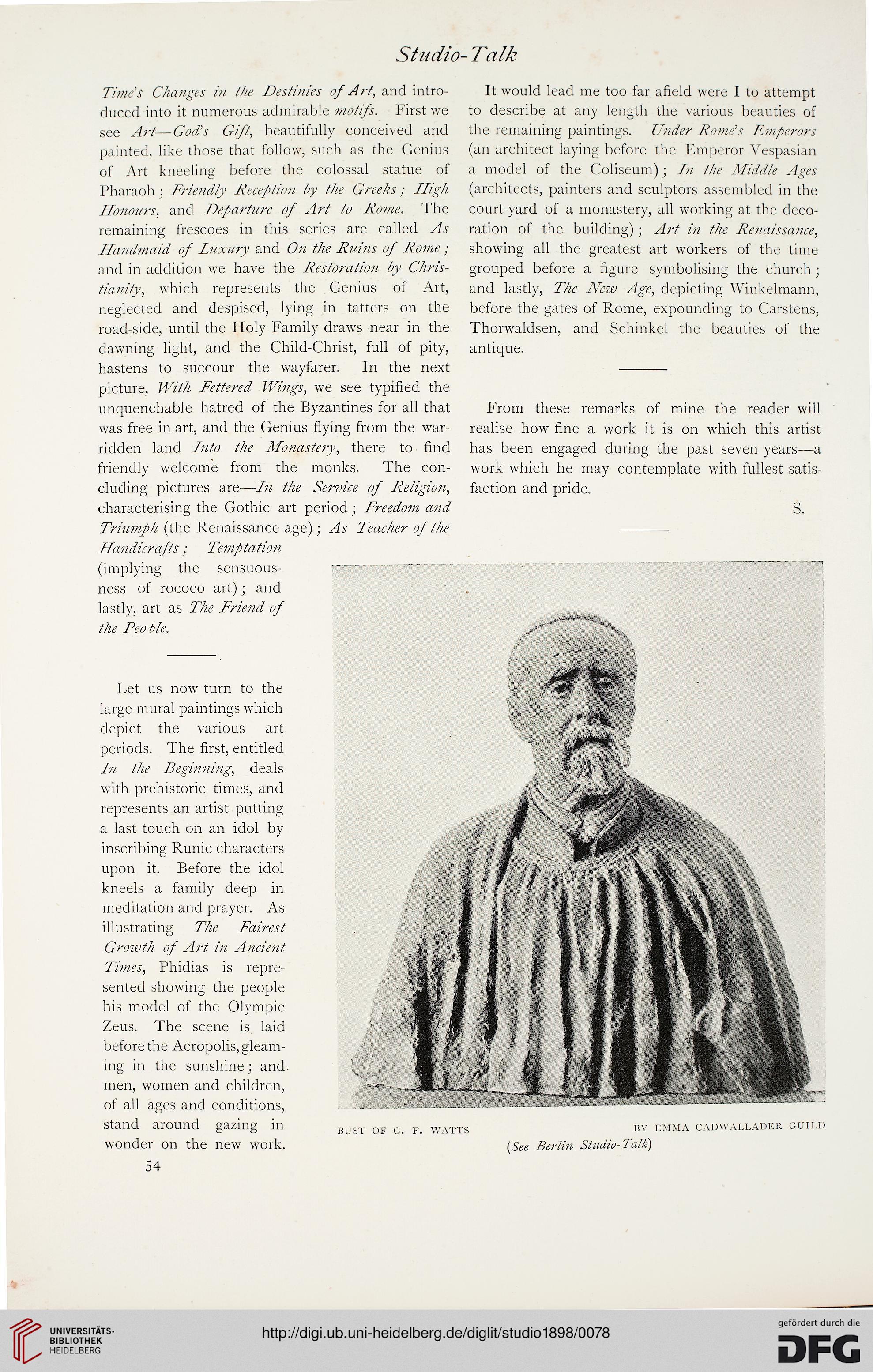Studio- Talk
Times Changes in the Destinies of Art, and intro It would lead me too far afield were I to attempt
duced into it numerous admirable motifs. First we to describe at any length the various beauties of
see Art—God's Gift, beautifully conceived and the remaining paintings. Under Rome's Emperors
painted, like those that follow, such as the Genius (an architect laying before the Emperor Vespasian
of Art kneeling before the colossal statue of a model of the Coliseum); /// the Middle Ages
Pharaoh ; Friendly Reception by the Greeks; High (architects, painters and sculptors assembled in the
Honours, and Departure of Art to Rome. The court-yard of a monastery, all working at the deco-
remaining frescoes in this series are called As ration of the building); Art in the Renaissance,
Handmaid of Luxury and On the Ruins of Rome; showing all the greatest art workers of the time
and in addition we have the Restoration by Chris- grouped before a figure symbolising the church ;
tianity, which represents the Genius of Art, and lastly, The New Age, depicting Winkelmann,
neglected and despised, lying in tatters on the before the gates of Rome, expounding to Carstens,
road-side, until the Holy Family draws near in the Thorwaldsen, and Schinkel the beauties of the
dawning light, and the Child-Christ, full of pity, antique.
hastens to succour the wayfarer. In the next -
picture, With Fette?-ed Wings, we see typified the
unquenchable hatred of the Byzantines for all that From these remarks of mine the reader will
was free in art, and the Genius flying from the war- realise how fine a work it is on which this artist
ridden land Into the Monastery, there to find has been engaged during the past seven years—a
friendly welcome from the monks. The con- work which he may contemplate with fullest satis-
eluding pictures are—In the Service of Religion, faction and pride.
characterising the Gothic art period; Freedom and S.
Triumph (the Renaissance age); As Teacher of the -
Handicrafts; Temptation
(implying the sensuous-
ness of rococo art); and
lastly, art as The Friend of
the People. j^"
Let us now turn to the
large mural paintings which
depict the various art
periods. The first, entitled
In the Beginning, deals
with prehistoric times, and
represents an artist putting
a last touch on an idol by
inscribing Runic characters
upon it. Before the idol
kneels a family deep in
meditation and prayer. As
illustrating The Fairest
Growth of Art in Ancient
Times, Phidias is repre-
sented showing the people
his model of the Olympic
Zeus. The scene is laid
before the Acropolis, gleam-
ing in the sunshine; and.
men, women and children,
of all ages and conditions,
stand around gazing in BUST 0F G< F> WAXTS by emma cadwallader guild
wonder on the new work. [See Berlin Studio-Talk)
54
Times Changes in the Destinies of Art, and intro It would lead me too far afield were I to attempt
duced into it numerous admirable motifs. First we to describe at any length the various beauties of
see Art—God's Gift, beautifully conceived and the remaining paintings. Under Rome's Emperors
painted, like those that follow, such as the Genius (an architect laying before the Emperor Vespasian
of Art kneeling before the colossal statue of a model of the Coliseum); /// the Middle Ages
Pharaoh ; Friendly Reception by the Greeks; High (architects, painters and sculptors assembled in the
Honours, and Departure of Art to Rome. The court-yard of a monastery, all working at the deco-
remaining frescoes in this series are called As ration of the building); Art in the Renaissance,
Handmaid of Luxury and On the Ruins of Rome; showing all the greatest art workers of the time
and in addition we have the Restoration by Chris- grouped before a figure symbolising the church ;
tianity, which represents the Genius of Art, and lastly, The New Age, depicting Winkelmann,
neglected and despised, lying in tatters on the before the gates of Rome, expounding to Carstens,
road-side, until the Holy Family draws near in the Thorwaldsen, and Schinkel the beauties of the
dawning light, and the Child-Christ, full of pity, antique.
hastens to succour the wayfarer. In the next -
picture, With Fette?-ed Wings, we see typified the
unquenchable hatred of the Byzantines for all that From these remarks of mine the reader will
was free in art, and the Genius flying from the war- realise how fine a work it is on which this artist
ridden land Into the Monastery, there to find has been engaged during the past seven years—a
friendly welcome from the monks. The con- work which he may contemplate with fullest satis-
eluding pictures are—In the Service of Religion, faction and pride.
characterising the Gothic art period; Freedom and S.
Triumph (the Renaissance age); As Teacher of the -
Handicrafts; Temptation
(implying the sensuous-
ness of rococo art); and
lastly, art as The Friend of
the People. j^"
Let us now turn to the
large mural paintings which
depict the various art
periods. The first, entitled
In the Beginning, deals
with prehistoric times, and
represents an artist putting
a last touch on an idol by
inscribing Runic characters
upon it. Before the idol
kneels a family deep in
meditation and prayer. As
illustrating The Fairest
Growth of Art in Ancient
Times, Phidias is repre-
sented showing the people
his model of the Olympic
Zeus. The scene is laid
before the Acropolis, gleam-
ing in the sunshine; and.
men, women and children,
of all ages and conditions,
stand around gazing in BUST 0F G< F> WAXTS by emma cadwallader guild
wonder on the new work. [See Berlin Studio-Talk)
54




